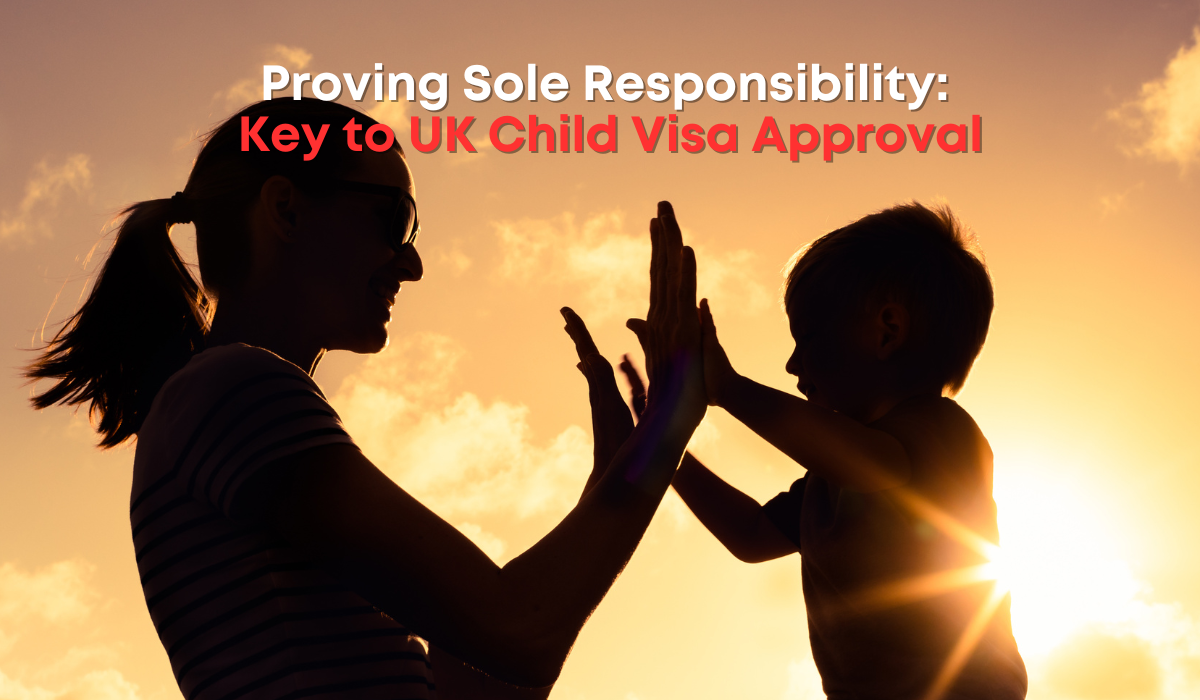Navigating the complexities of UK immigration law is no small feat, particularly when dealing with the sensitive matter of child visa applications. For parents or guardians seeking to bring a non-British child to the UK for settlement, the concept of “sole responsibility” is often a key hurdle. This requirement, under Appendix FM, Paragraph 297, and other provisions of the Immigration Rules, demands a thorough understanding and robust evidence to satisfy Home Office standards.
This article delves into the legal framework surrounding sole responsibility, its application in child visa cases, and the critical evidence required to succeed.
Child Visa Applications and the Sole Responsibility Requirement
When only one parent is moving to or resides in the UK, the Immigration Rules assume that the child should typically remain with the other parent, unless the moving parent can demonstrate sole responsibility. This principle is particularly relevant in two scenarios:
- Child of a Partner or Parent Visa under Appendix FM
This visa applies to non-British children whose parent has, or is being granted, a Partner or Parent Visa under Appendix FM. In cases where only one parent (Parent A) is moving to or resides in the UK, they must prove one of the following:- Parent A has sole responsibility for the child’s upbringing, or
- There are serious and compelling family or other considerations making the child’s exclusion undesirable, with suitable care arrangements in place.
- The threshold for meeting the “exclusion undesirable” test is high, as clarified in Mundeba (s.55 and para 297(i)(f)) [2013] UKUT 00088. The Tribunal stressed that the test requires examining the child’s circumstances, including neglect, abuse, or unstable care arrangements.
- Applications under Paragraph 297
When the parent(s) or relative(s) of a child are present and settled in the UK through a different route, the child may join them under Paragraph 297. This rule requires demonstrating that:- The applying parent has sole responsibility for the child, or
- Serious and compelling reasons make the child’s exclusion undesirable.
- Case law underscores the difficulty of meeting the “exclusion undesirable” standard, making it vital to focus on proving sole responsibility where applicable.
Defining Sole Responsibility
The Home Office’s Family Policy Guidance defines sole responsibility as “sole control in setting and providing the day-to-day direction and care for the child’s welfare.” Notably, this concept transcends legal custody, focusing instead on who holds continuing authority over the child’s upbringing. Key considerations include:
- Decision-making authority regarding education, medical care, and religious upbringing.
- Financial responsibility for the child’s needs.
- Welfare considerations, such as evidence of direct involvement in the child’s daily life and protection.
The landmark case TD (Paragraph 297 (i) (e): “sole responsibility”) Yemen [2006] UKAIT 00049 clarified that sole responsibility involves ongoing control over the child’s upbringing, even when day-to-day care is shared with others due to geographical separation.
Proving Sole Responsibility
To succeed in a child visa application, applicants must provide substantial evidence demonstrating sole responsibility. Commonly accepted evidence includes:
- Court documents showing sole custody.
- Medical records and school reports.
- Bank statements evidencing financial support.
- Letters from friends and family corroborating the applicant’s role.
- Communication logs with the child or their caregivers.
The Home Office assesses these factors holistically, considering whether the parent has made all key decisions in the child’s life and maintained control despite any physical separation.
Best Interests of the Child
Under Section 55 of the Borders, Citizenship and Immigration Act 2009, the Home Office must prioritize the child’s welfare in all decisions. While Section 55 technically applies to children in the UK, its principles extend to out-of-country applications through guidance such as Every Child Matters – Change for Children. Case law, including Mundeba and SG (child of a polygamous marriage) Nepal [2012] UKUT 265, emphasizes that a child’s best interests are generally served by being with at least one parent.
The October 2024 update to Appendix Children underscores the importance of assessing whether there are good reasons for a child not to stay overseas with the other parent. This guidance may suggest a slightly lower threshold than the exclusion undesirable test, though the precise impact remains to be seen.
Recent Developments and Future Implications
The evolving interpretations of sole responsibility and its interplay with Appendix Children raise critical questions for practitioners. While Appendix Children aims to streamline child-dependent applications, the enduring relevance of sole responsibility remains crucial. This calls for a meticulous approach to gathering evidence and presenting a compelling case.
Final Takes
The concept of sole responsibility is both intricate and essential in UK child visa applications. Understanding its nuances and presenting strong evidence are vital for achieving successful outcomes. As immigration law continues to evolve, staying informed and seeking professional advice is paramount to navigating these challenging legal waters.
Get in touch: For a comprehensive understanding of your options or queries on UK immigration matters, contact GigaLegal Solicitors at 02074067654 or click here to book a no-obligation consultation with an immigration expert.


